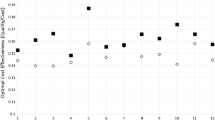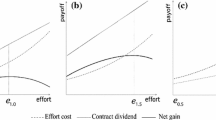Abstract
Many agri-environmental conservation programs are faced with the problem of imperfect monitoring. This provides farmers with an incentive for noncompliance, because they can receive subsidies without implementing the conservation scheme. In this paper, bidding behavior and auction performance are compared for discriminatory-price and uniform-price auctions in an imperfect monitoring environment. Our theoretical analysis suggests that auction performances are equalized between the discriminatory-price and uniform-price auctions. However, laboratory experiments reveal that, although the discriminatory-price auction has an advantage in terms of reducing policy costs, it is more likely to cause adverse selection. As a result, the uniform-price auction tends to have higher efficiency and cost-effectiveness when compliance behavior is taken into account.
Similar content being viewed by others
Abbreviations
- DP:
-
Discriminatory-price auction
- UP:
-
Uniform-price auction
References
Abbink K, Brandts J, McDaniel T (2003) Asymmetric demand information in uniform and discriminatory call auctions: an experimental analysis motivated by electricity markets. J Regul Econ 23(2): 125–144
Aldenderfer MS, Blashfield K (1984) Cluster analysis. Sage, Beverly Hills
Alm J, Jacobson S (2007) Using laboratory experiments in public economics. Natl Tax J 60(1): 129–152
Alm J, Jackson B, McKee M (1992) Institutional uncertainty and taxpayer compliance. Am Econ Rev 82(4): 1018–1026
Anderson CM, Holland DS (2006) Auctions for initial sale of annual catch entitlement. Land Econ 82(3): 333–352
Cason TN, Gangadharan L (2005) A laboratory comparison of uniform and discriminative price auctions for reducing non-point source pollution. Land Econ 81(1): 51–70
Cason TN, Gangadharan L (2006) Emissions variability in tradable permit markets with imperfect enforcement and banking. J Econ Behav Organ 61(2): 199–216
Cason TN, Gangadharan L, Duke C (2003) A laboratory study of auctions for reducing non-point source pollution. J Environ Econ Manag 46(3): 446–471
Choe C, Fraser I (1998) A note on imperfect monitoring of agri-environmental policy. J Agric Econ 49(2): 250–258
Choe C, Fraser I (1999) Compliance monitoring and agri-environmental policy. J Agric Econ 50(3): 468–487
Fraser R (2002) Moral hazard and risk management in agri-environmental policy. J Agric Econ 53(3): 475–488
Hailu A, Thoyer S (2007) Designing multi-unit multiple bid auctions: an agent-based computational model of uniform, discriminatory and generalised vickrey auctions. Econ Rec 83(s1): S57–S72
Hart R, Latacz-Lohmann U (2005) Combating moral hazard in agri-environmental schemes: a multiple-agent approach. Eur Rev Agric Econ 32(1): 75–91
Kagel JK, Levin D (1986) The winner’s curse and public information in common value auctions. Am Econ Rev 76(5): 894–920
Kahneman D, Tversky A (1979) Prospect theory: an analysis of decision under risk. Econometrica 47(2): 263–291
Latacz-Lohmann U, van der Hamsvoort C (1997) Auctioning conservation contracts: a theoretical analysis and an application. Am J Agric Econ 79(2): 407–418
Latacz-Lohmann U, Schilizzi S (2005) Auctions for conservation contracts: a review of the theoretical and empirical literature. Report to the Scottish Executive Environment and Rural Affairs Department (Project No: UKL/001/05)
Lusk J, Shogren JF (2007) Experimental auctions: methods and applications in economic and marketing research. Cambridge University Press, Cambridge
MAFF (Ministry of Agriculture, Forestry and Fisheries) (2004) Kankyo hozengata nogyo (inasaku) suishin noka no keiei bunseki chosa houkoku (Farm survey of organic rice farming). Tokyo
Malik AS (1990) Markets for pollution control when firms are noncompliant. J Environ Econ Manag 18(1): 97–106
Marette S, Roosen J, Blanchemanche S (2008) Taxes and subsidies to change eating habits when information is not enough: an application to fish consumption. J Regul Econ 34(2): 119–143
McKee M, Berrens RP (2001) Balancing army and endangered species concerns: green vs. green. Environ Manage 27(1): 123–133
Moxey A, White B, Ozanne A (1999) Efficient contract design for agri-environment policy. J Agric Econ 50(2): 187–202
Murphy JJ, Stranlund JK (2006) Direct and market effects of enforcing emissions trading programs: an experimental analysis. J Econ Behav Organ 61(2): 217–233
Murphy JJ, Stranlund JK (2007) A laboratory investigation of compliance behavior under tradable emissions rights: implications for targeted enforcement. J Environ Econ Manag 53(2): 196–212
Nyborg KG, Sundaresan S (1996) Discriminatory versus uniform treasury auctions: evidence from when-issued transactions. J Financ Econ 42(1): 63–104
Ozanne A, Hogan T, Colman D (2001) Moral hazard, risk aversion and compliance monitoring in agri- environmental policy. Eur Rev Agric Econ 28(3): 329–347
Rose SL, Levin D (2008) An experimental investigation of the explosive effect in almost common value auctions. J Econ Behav Organ 67(3–4): 927–946
Schilizzi S, Latacz-Lohmann U (2007) Assessing the performance of conservation auctions: an experimental study. Land Econ 83(4): 497–515
Selten R, Chmura T, Pitz T, Kube S, Schreckenberg M (2007) Commuters route choice behaviour. Games Econ Behav 58(2): 394–406
Stranlund JK, Dhanda KK (1999) Endogenous monitoring and enforcement of a transferable emissions permit system. J Environ Econ Manag 38(3): 267–282
Tenorio R (1993) Revenue equivalence and bidding behavior in a multi-unit auction market: an empirical analysis. Rev Econ Stat 75(2): 302–314
Umlauf SR (1993) An empirical study of the mexican treasury bill auction. J Financ Econ 33(3): 313–340
Vickrey W (1961) Counterspeculation, auctions, and competitive sealed tenders. J Finance 16(1): 8–37
Wu J (2009) Environmental compliance: the good, the bad, and the super green. J Environ Manag 90(11): 3363–3381
Author information
Authors and Affiliations
Corresponding author
Rights and permissions
About this article
Cite this article
Kawasaki, K., Fujie, T., Koito, K. et al. Conservation Auctions and Compliance: Theory and Evidence from Laboratory Experiments. Environ Resource Econ 52, 157–179 (2012). https://doi.org/10.1007/s10640-012-9551-9
Accepted:
Published:
Issue Date:
DOI: https://doi.org/10.1007/s10640-012-9551-9




